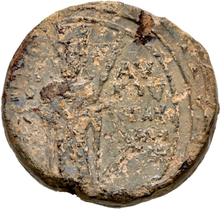| Irene Laskarina | |
|---|---|
 Seal of Irene Laskarina Seal of Irene Laskarina | |
| Empress consort of Nicaea | |
| Tenure | 1222–1240 |
| Died | 1240 |
| Spouse | Andronikos Palaiologos John III Doukas Vatatzes |
| Issue | Theodore II Vatatzes |
| House | Laskaris |
| Father | Theodore I Laskaris |
| Mother | Anna Angelina |
Irene Laskarina (born c. 1194-1199 CE, died 1240 CE) (Greek: Εἰρήνη Λασκαρίνα, Eirēnē Laskarina) was Empress consort of Nicaea. She was a daughter of Theodore I Laskaris, emperor of Nicaea and Anna Komnene Angelina. Her maternal grandparents were Alexios III Angelos and Euphrosyne Doukaina Kamatera. Her sister, Maria Laskarina, married Béla IV of Hungary.
In 1204 CE, during Irene Laskarina's childhood, the city of Constantinople fell to a Crusader army during the Sack of Constantinople. Much of the nobility, including Irene's family, fled, and re-established a capitol in Nicaea; this became the Nicaean empire.
Irene first married the general Andronikos Palaiologos, and after his death became the wife of Theodore's designated successor, the future John III Doukas Vatatzes in 1212. They had a son, the future Theodore II Laskaris. After the latter's birth, she fell from a horse and was so badly injured that she was unable to have any more children. She retired to a convent, taking the monastic name Eugenia, and died there in summer of 1240, some fourteen years before her husband.
Irene is praised by historians for her modesty and prudence and is said to have brought about by her example a considerable improvement in the morals of her nation.
Notes
- ^ Sweeney, Naoíse Mac (2023-05-23). The West: A New History in Fourteen Lives. Penguin. ISBN 978-0-593-47219-4.
- ^ Saint-Guillain, Guillaume (2016-09-17). Identities and Allegiances in the Eastern Mediterranean after 1204. Routledge. ISBN 978-1-317-11913-5.
- ^ "Theodore Lascaris s.v. Irene Lascaris" . Encyclopædia Britannica. Vol. 23 (11th ed.). 1911. p. 766.
- "The Aristocracy and the Empire of Nicaea", Identities and Allegiances in the Eastern Mediterranean after 1204, Routledge, pp. 87–98, 2016-09-17, doi:10.4324/9781315587738-13, ISBN 978-1-315-58773-8, retrieved 2024-08-20
- Monte, Francesco Maria del (2024-06-22). Byzanz in Trümmern: Strategien und Widerstand der byzantinischen Staaten nach dem vierten Kreuzzug (in German). tredition. ISBN 978-3-384-26935-5.
- Murata, Koji; Ichikawa, Kohei; Fujii, Yuri I.; Hayakawa, Hisashi; Cheng, Yongchao; Kawamoto, Yukiko; Sano, Hidetoshi (2021), "Cometary records revise Eastern Mediterranean chronology around 1240 CE", Publications of the Astronomical Society of Japan, 73: 197–204, arXiv:2012.00976, doi:10.1093/pasj/psaa114
| Irene Laskarina LaskarisBorn: ? Died: 1240 | ||
| Royal titles | ||
|---|---|---|
| Preceded byMarie de Courtenay | Empress consort of Nicaea 1221–1240 |
Succeeded byAnna of Hohenstaufen |